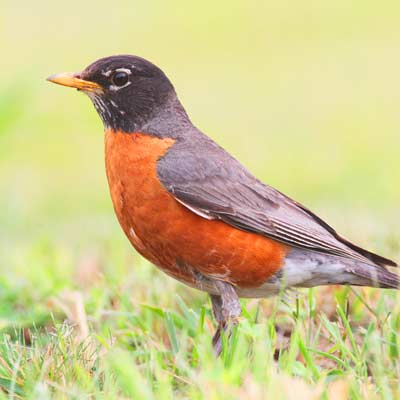 The American Robin is a common and familiar bird in southwest Ohio. It is a member of the thrush family, Turdidae, and is known for its bright red breast and melodious song. Robins are about 10 inches long and weigh about 1/2 ounce. They have a long, slender bill and a short tail. Their plumage is brown above and white below, with a distinctive red breast. Robins are found in a variety of habitats, including forests, woodlands, parks, and gardens. They are omnivorous and eat a variety of insects, worms, fruits, and berries.
The American Robin is a common and familiar bird in southwest Ohio. It is a member of the thrush family, Turdidae, and is known for its bright red breast and melodious song. Robins are about 10 inches long and weigh about 1/2 ounce. They have a long, slender bill and a short tail. Their plumage is brown above and white below, with a distinctive red breast. Robins are found in a variety of habitats, including forests, woodlands, parks, and gardens. They are omnivorous and eat a variety of insects, worms, fruits, and berries.
Robins are a symbol of spring in southwest Ohio. They are one of the first birds to return to the area in the spring, and their arrival is often seen as a sign that winter is over. Robins are also a popular bird with birdwatchers. They are relatively easy to see and identify, and their song is a welcome sound in the springtime.
Robins play an important role in the ecosystem. They help to control insect populations, and they also disperse seeds. Robins are also a food source for other animals, such as hawks, owls, and snakes.
Unfortunately, robins are facing a number of threats. One of the biggest threats is habitat loss. As forests and woodlands are cleared for development, robins are losing their homes. Another threat is climate change. Climate change is causing changes in weather patterns, which can make it difficult for robins to find food and raise their young.
There are a number of things that can be done to help robins. One of the most important things is to protect their habitat. This can be done by planting trees and shrubs in your yard, and by supporting organizations that are working to protect forests and woodlands. You can also help robins by providing them with food and water. You can do this by putting out bird feeders and birdbaths in your yard.
Robins are a beautiful and important part of the natural world. By taking steps to protect their habitat and provide them with food and water, we can help ensure that these birds continue to thrive in southwest Ohio.
Here are some additional facts about robins:
- Robins are monogamous and mate for life.
- Robins typically lay 4-5 eggs, which hatch after about 12 days.
- Both parents help to care for the young, which fledge after about 14 days.
- Robins can live for up to 10 years in the wild.
If you see a robin, please take a moment to enjoy its beauty and listen to its song. These birds are a reminder of the beauty of nature and the importance of conservation.
